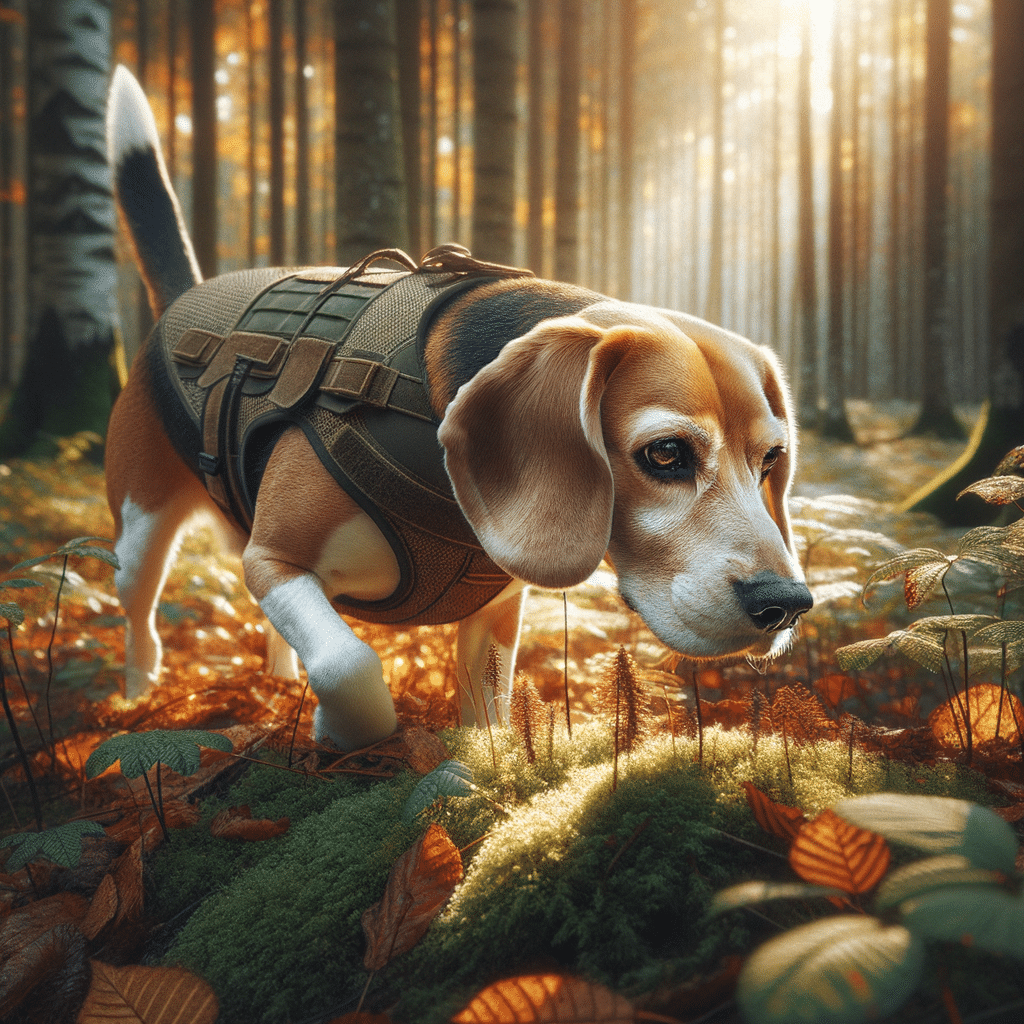Beagles are intelligent dogs known for their eagerness to please, which makes them relatively straightforward to train with the correct methods. Training any dog requires patience and consistency, and beagles are no exception.
In This Article
Beagles are pack animals that thrive on companionship and positive reinforcement. Starting with basic commands and gradually moving to more complex tasks can effectively teach your beagle new tricks.
Understanding the breed’s characteristics is crucial in training your beagles. They have a strong sense of smell, and hunters have historically used them for hunting small game, including rabbit hunting. Which means they can easily be distracted by scents.
Therefore, train your beagle in a controlled environment and use techniques that keep their attention. Short and engaging training sessions, rewarding successes, and a good routine will produce the best results. Beagles respond well to a clear structure because it makes learning new tricks a fun and rewarding experience.
Highlights
- Beagle training requires understanding this dog breed's active and inquisitive nature.
- Positive reinforcement and consistency are essential in beagle training.
- Controlled training environments help minimize distractions and improve learning.
Understanding Your Beagle
Before diving into training, it’s crucial to understand a beagle’s personality and intelligence. Recognizing these traits will help you form a better bond and capture your pet’s attention during training sessions.
Beagle Temperament
Beagles are known for their lively and curious nature. Their history of working alongside hunters explains their strong instinct to track scents and explore their environment. Their temperament can be characterized by:
- Eager to please, often responds well to positive reinforcement.
- May exhibit stubbornness, requiring patience and consistency in training.
- Social and friendly, beagles thrive on companionship.
Beagles’ energy levels often translate to enthusiasm for learning but can also lead to restlessness. Without mental stimulation, they might resort to howling, pacing, or chewing.
Beagle Intelligence
Beagles rank highly in scent intelligence, given their history as scent hounds. These traits include:
- An excellent sense of smell often contributes to their curiosity.
- Independent thinking is a trait from their hunting days.
- Ability to learn a wide range of commands and tricks with the right approach.
Though they’re smart, their intelligence may manifest differently than obedience-focused breeds. Training them requires cultivating their strengths, like their keen sense of smell and love for exploration. Create engaging and stimulating training sessions to develop their intellect effectively.
Essential Training Techniques
Teaching beagle tricks requires a blend of scientifically-backed techniques, an established routine, and unwavering consistency. These elements streamline the training process and create a bond of trust and communication between you and your dog.
Positive Reinforcement
Positive reinforcement techniques are the cornerstone of modern dog training. This method involves rewarding desired behaviors and encouraging the dog to repeat them. For beagles, rewards can be treats, praise, or playtime. The key is to offer the reward immediately after your dog performs the desired action to reinforce the connection between good behavior and the reward.
Rewards for Good Behavior
- Sit: Treat given right after sitting
- Stay: Praise offered after holding the position
- Come: Playtime when they arrive promptly
Creating a Training Routine
A structured training routine is crucial to the learning process. Beagles thrive on predictable patterns, which helps focus their attention and remember commands. Keep training sessions short, no longer than 10–15 minutes, to maintain the dog’s interest and avoid frustration.
Example Training Schedule
- Morning: 10 minutes of basic command practice
- Afternoon: 5 minutes of recall training
- Evening: 10 minutes of new trick introduction
The Importance of Consistency
Consistency in training means using the same commands, rewards, and discipline every time. This helps your beagle understand what is expected of them and builds their confidence in responding to verbal commands. Staying calm and patient during training sessions also helps create a stress-free training environment.
Consistent Elements
- Commands: Same word and tone for each command
- Rewards: Same type of treat for specific behaviors
- Discipline: Consistent correction technique without aggression
Teaching Basic Commands
Training your beagle requires patience and consistency, focusing on basic commands as the foundation for obedience. By using treats and frequent practice, you can effectively train your dogs to understand and respond to commands such as “sit,” “come,” and “stay.”
Command: Sit
To teach a beagle to sit, start in a distraction-free environment. Hold a treat close to the dog’s nose and then move it upwards, naturally encouraging the dog to sit down to follow the treat with its eyes. As the dog sits, use the “sit” command. Once seated, immediately give your dog the treat and praise. Consistency is key, so repeating this exercise multiple times daily can help reinforce the behavior.
Command: Come
The “come” command is crucial for a beagle owner to maintain control and ensure safety. Starting with a leash, gently tug on it while saying “come,” and then reward your pet with treats and affection if it obeys your verbal command. Gradually practice this command while increasing distance and eventually without a leash. To keep the experience positive, it’s important to use positive reinforcement and never scold the dog if it does not come immediately.
Command: Stay
Training a beagle to stay requires teaching them to remain in a spot despite distractions. To start, tell your pup to sit or lie down. Then, while holding an open palm towards them, step back and say “Stay.” Start with stepping back a short distance and for a few seconds. If the Beagle stays, reward them with a treat. Gradually increase the distance and time before giving the treat to reinforce the command. Practice and patience are essential for mastering this command.
Advanced Tricks and Activities
Teaching your beagle advanced tricks provides excellent mental stimulation and enhances your pet’s obedience and agility. These activities promote a deeper bond between you and your dog while keeping the beagle healthy and entertained.
Teaching Fetch
Fetching is a thrilling way to exercise your pet’s body and mind.
- Start with a favorite toy to get their attention.
- Toss the toy a short distance and say “Fetch.”
- Use a clicker or verbal praise to reinforce the behavior when your beagle picks it up.
- Encourage them to return the toy for a reward. Over time, increase the distance.
Learning Agility
Agility training is a perfect outlet for a beagle’s high energy and sharp intelligence. Following these steps can guide your dog.
- Begin with simple obstacles like cones or hoops.
- Use treats and a clicker for positive reinforcement.
- Practice consistently, gradually introducing more complex equipment like tunnels and weave poles.
- Consider enrolling in classes with a dog trainer for structured progress.
Fun Tricks: Play Dead and Roll Over
Teaching your beagle fun tricks like “play dead” and “roll over” provides delightful entertainment and mental exercise.
For “Play Dead”
1. Cue your beagle to lie down.
2. Use the “Play Dead” command and gently roll them onto their side.
3. Reward them while they stay still, gradually building up the time they remain ‘dead.’
For “Roll Over”
1. Start with your dog lying down.
2. Hold a treat by their nose and lead it around to their shoulder so they naturally roll over.
3. As they perform the roll, say “roll over” and provide plenty of praise and treats.
Each trick instills discipline and creates an opportunity to play with your beagle. Remember, consistency and patience are key in all advanced dog training activities.
Frequently Asked Questions
This section addresses key techniques and strategies specific to beagle training using frequently asked questions.
What are effective techniques for scent-training a beagle?
Scent training a beagle may involve using treats to create a scent trail and giving them the command to “find.” It’s essential to start with short distances and gradually increase difficulty as the beagle’s scent-tracking abilities improve.
What methods work best for training a beagle puppy to avoid biting?
When a beagle puppy bites, give them a firm “no” and replace the object of biting with a chew toy. Consistency and positive reinforcement, when the puppy bites the toy instead of hands or furniture, are key to effective training.
How can I modify my beagle’s behavior to reduce or eliminate excessive barking?
To reduce excessive barking in beagles, first, identify the cause and address it directly. Common causes include boredom, alarm, or attention-seeking. Training commands like “quiet” and rewards when they stop barking can also be effective.
What should be the primary focus when training an adult beagle?
Training an adult beagle should focus on consistency and patience. Reward desired behaviors consistently, reinforcing commands they may already know and slowly introducing new ones.
What are some helpful beagle training tips for new dog owners?
New dog owners should establish a routine, use treats as incentives, and keep training sessions short and enjoyable to capture the beagle’s attention and encourage learning.
Are there any specific strategies for beagles that make them easier to train?
Beagles respond well to positive reinforcement and consistency due to their intelligent but sometimes stubborn nature. Breaking tasks into small steps and rewarding the dog immediately after the desired action can make training more effective.






